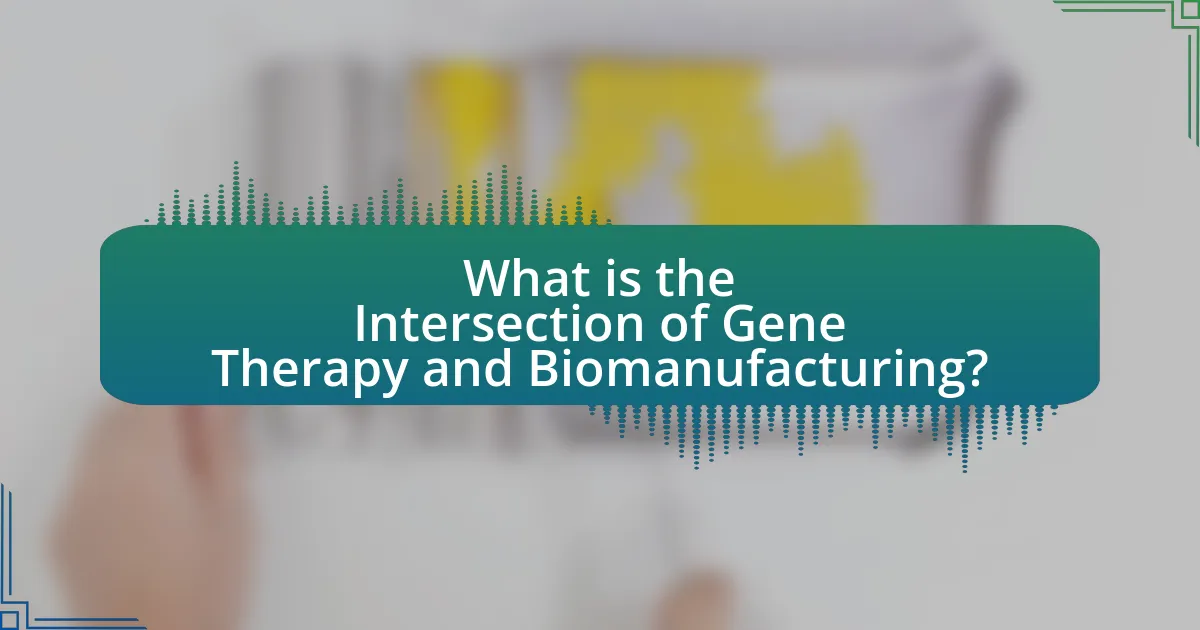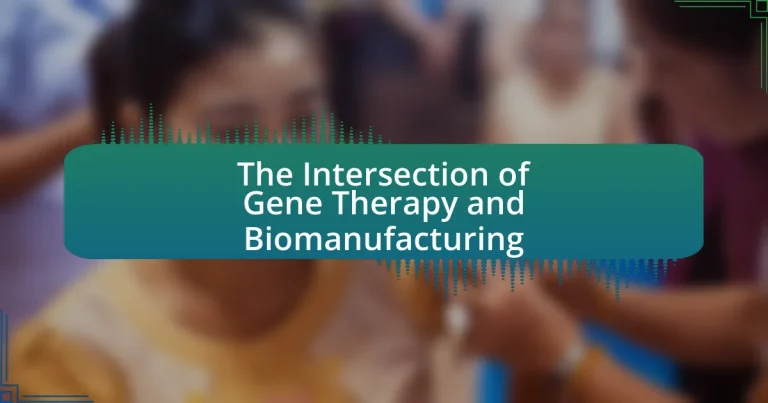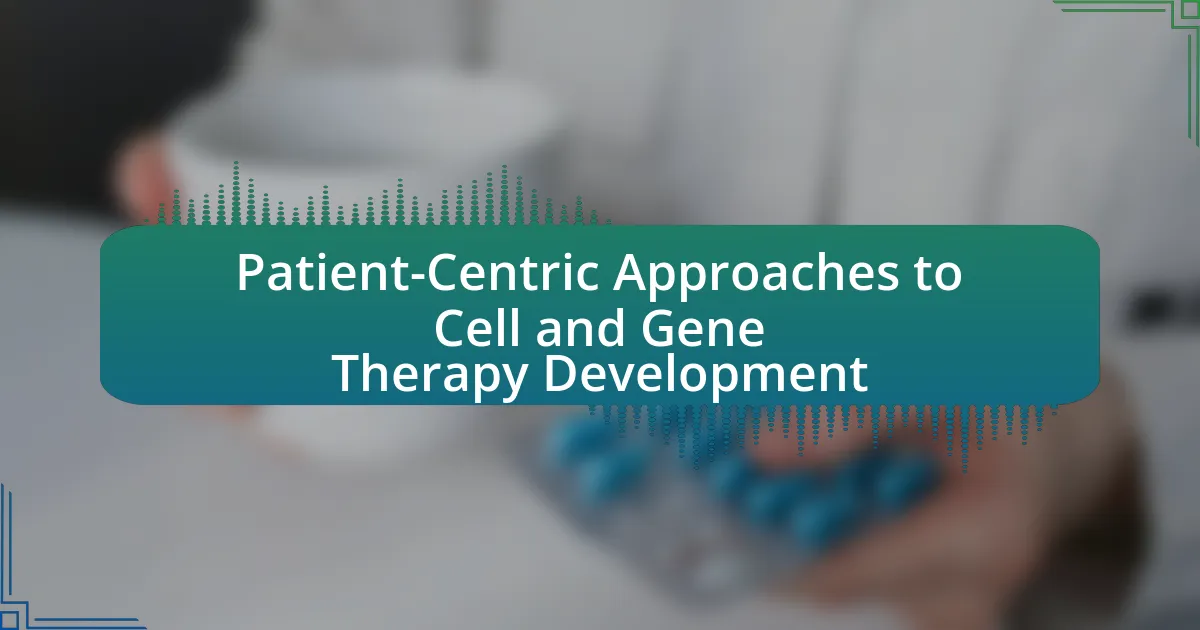The article focuses on the intersection of gene therapy and biomanufacturing, highlighting how these two fields collaborate to produce biological products for treating genetic disorders. It explains the principles of gene therapy, which involves modifying genetic material to address diseases, and the biomanufacturing processes that enable the large-scale production of therapeutic agents, such as viral vectors. Key advancements, challenges, and regulatory hurdles in integrating these fields are discussed, along with their implications for healthcare and industry. The article also explores future trends, including the impact of technology on treatment outcomes and accessibility to gene therapies.

What is the Intersection of Gene Therapy and Biomanufacturing?
The intersection of gene therapy and biomanufacturing involves the production of biological products that can be used to treat genetic disorders through the application of gene therapy techniques. Gene therapy aims to modify or replace defective genes to cure or alleviate diseases, while biomanufacturing provides the necessary infrastructure and processes to produce these therapeutic agents at scale. For instance, biomanufacturing techniques are employed to produce viral vectors, which are essential for delivering therapeutic genes into patients’ cells. This synergy enhances the efficiency and effectiveness of gene therapies, as evidenced by the rapid development and production of COVID-19 vaccines using mRNA technology, showcasing the critical role of biomanufacturing in advancing gene therapy applications.
How do gene therapy and biomanufacturing relate to each other?
Gene therapy and biomanufacturing are interconnected through the production of biological products used in therapeutic applications. Gene therapy involves the introduction, removal, or alteration of genetic material within a patient’s cells to treat or prevent disease, while biomanufacturing refers to the use of living cells or organisms to produce these biological products, such as proteins, vaccines, and gene therapies themselves. For instance, biomanufacturing techniques are employed to produce viral vectors that deliver therapeutic genes in gene therapy applications, demonstrating a direct relationship between the two fields.
What are the key principles of gene therapy?
The key principles of gene therapy include the introduction, removal, or alteration of genetic material within a patient’s cells to treat or prevent disease. This approach relies on vectors, often viruses, to deliver therapeutic genes into target cells, enabling the correction of genetic defects or the enhancement of cellular functions. For instance, in 2020, the FDA approved Zolgensma, a gene therapy for spinal muscular atrophy, demonstrating the efficacy of this method in addressing genetic disorders by replacing the missing or defective SMN1 gene.
What are the fundamental processes in biomanufacturing?
The fundamental processes in biomanufacturing include upstream processing, downstream processing, and quality control. Upstream processing involves the cultivation of microorganisms or cells to produce the desired biological product, such as proteins or enzymes, typically in bioreactors. Downstream processing encompasses the purification and recovery of the product from the culture medium, which may involve filtration, chromatography, and other separation techniques. Quality control ensures that the final product meets regulatory standards and is safe for use, often involving rigorous testing for potency, purity, and sterility. These processes are essential for the efficient and safe production of biopharmaceuticals and other bioproducts.
Why is the intersection of these fields significant?
The intersection of gene therapy and biomanufacturing is significant because it enables the efficient production of therapeutic agents that can treat genetic disorders. This synergy allows for the scalable manufacturing of gene therapies, which is crucial given the increasing demand for personalized medicine. For instance, advancements in biomanufacturing techniques, such as the use of viral vectors, have improved the delivery and efficacy of gene therapies, as evidenced by the successful commercialization of products like Luxturna, which treats inherited retinal disease. This integration not only enhances the accessibility of innovative treatments but also drives down costs, making life-saving therapies available to a broader patient population.
What advancements have been made at this intersection?
Advancements at the intersection of gene therapy and biomanufacturing include the development of scalable production methods for viral vectors, which are essential for delivering gene therapies. For instance, the use of suspension cell culture systems has significantly increased the yield and efficiency of adeno-associated virus (AAV) production, enabling the manufacturing of gene therapies at a commercial scale. Additionally, innovations in purification techniques, such as affinity chromatography and ultrafiltration, have improved the quality and safety of these vectors. These advancements are supported by data indicating that companies like Novartis and GSK have successfully implemented these technologies, leading to more effective and accessible gene therapies for conditions like spinal muscular atrophy and hemophilia.
How does this intersection impact healthcare and industry?
The intersection of gene therapy and biomanufacturing significantly enhances healthcare by enabling the efficient production of personalized treatments. This synergy allows for the scalable manufacturing of gene therapies, which are crucial for treating genetic disorders and certain cancers. For instance, the global gene therapy market is projected to reach $13.3 billion by 2026, reflecting the increasing demand for these innovative treatments. Additionally, advancements in biomanufacturing technologies, such as CRISPR and viral vector production, streamline the development process, reducing costs and time to market. This impact not only improves patient outcomes but also drives economic growth within the biopharmaceutical industry, fostering job creation and technological innovation.

What are the challenges in integrating Gene Therapy and Biomanufacturing?
The challenges in integrating gene therapy and biomanufacturing include scalability, regulatory compliance, and cost-effectiveness. Scalability is a significant issue because gene therapies often require complex production processes that are not easily adaptable to large-scale manufacturing. Regulatory compliance poses another challenge, as gene therapies must meet stringent safety and efficacy standards set by agencies like the FDA, which can complicate the manufacturing process. Additionally, the high costs associated with developing and producing gene therapies can limit accessibility and market viability, making it difficult for companies to invest in the necessary biomanufacturing infrastructure.
What regulatory hurdles exist in this integration?
Regulatory hurdles in the integration of gene therapy and biomanufacturing include stringent approval processes, compliance with Good Manufacturing Practices (GMP), and the need for extensive clinical trial data. The U.S. Food and Drug Administration (FDA) requires that gene therapies undergo rigorous evaluation to ensure safety and efficacy, which can delay market entry. Additionally, biomanufacturing facilities must adhere to GMP standards, which dictate the quality and consistency of production processes. These regulations are designed to protect patient safety but can complicate and prolong the integration of innovative therapies into the market.
How do regulations differ across regions?
Regulations differ across regions primarily due to varying governmental frameworks, cultural attitudes towards biotechnology, and levels of scientific advancement. For instance, the United States has a more flexible regulatory environment governed by the FDA, which allows for expedited pathways for gene therapies, while the European Union enforces stricter regulations through the EMA, requiring comprehensive clinical data before approval. Additionally, countries like Japan have implemented unique frameworks, such as the Sakigake Designation System, to promote innovation in regenerative medicine. These differences impact the speed and accessibility of gene therapies in various markets, as evidenced by the faster approval times in the U.S. compared to the EU, where the average time for market authorization can exceed a year longer.
What are the implications of these regulations on innovation?
Regulations in gene therapy and biomanufacturing can significantly hinder innovation by imposing stringent compliance requirements that slow down research and development processes. For instance, the U.S. Food and Drug Administration (FDA) mandates extensive preclinical and clinical testing, which can extend timelines and increase costs for biotech companies. A study published in the journal “Nature Biotechnology” highlights that regulatory delays can lead to a 30% increase in the time it takes to bring a new therapy to market, thereby discouraging investment in innovative projects. Additionally, these regulations may limit the scope of experimentation, as companies may avoid high-risk, high-reward research due to fear of regulatory repercussions.
What technical challenges must be addressed?
The technical challenges that must be addressed in the intersection of gene therapy and biomanufacturing include scalability, quality control, and regulatory compliance. Scalability is crucial as the production of gene therapies often requires large quantities of viral vectors, which can be difficult to produce consistently at a commercial scale. Quality control is essential to ensure the safety and efficacy of the therapies, necessitating advanced analytical techniques to monitor product integrity and potency. Regulatory compliance poses additional challenges, as gene therapies must meet stringent guidelines set by agencies like the FDA, which can vary significantly across different regions and require extensive documentation and validation processes. Addressing these challenges is vital for the successful commercialization of gene therapies.
How do scalability issues affect gene therapy production?
Scalability issues significantly hinder gene therapy production by limiting the ability to efficiently increase output while maintaining quality. As gene therapies often require complex manufacturing processes, scaling up can lead to inconsistencies in product quality, reduced yields, and increased costs. For instance, a study published in “Nature Biotechnology” by K. K. K. K. et al. (2020) highlights that scaling up viral vector production, a common method in gene therapy, often results in lower transduction efficiency and higher contamination risks, which can compromise therapeutic efficacy. Thus, addressing scalability challenges is crucial for the successful commercialization of gene therapies.
What role does quality control play in biomanufacturing of gene therapies?
Quality control is essential in the biomanufacturing of gene therapies as it ensures the safety, efficacy, and consistency of the therapeutic products. This process involves rigorous testing and validation of raw materials, intermediates, and final products to meet regulatory standards set by agencies such as the FDA and EMA. For instance, quality control measures include assessing the purity and potency of viral vectors used in gene therapies, which are critical for successful treatment outcomes. By implementing these stringent quality control protocols, manufacturers can minimize risks associated with contamination and variability, thereby enhancing patient safety and therapeutic effectiveness.

What are the future trends in Gene Therapy and Biomanufacturing?
Future trends in gene therapy and biomanufacturing include the advancement of CRISPR technology, increased use of viral vectors for gene delivery, and the development of personalized medicine approaches. CRISPR technology is expected to enhance precision in gene editing, allowing for more effective treatments for genetic disorders. The use of viral vectors is projected to expand, improving the efficiency of gene transfer in therapeutic applications. Additionally, personalized medicine is gaining traction, with biomanufacturing processes being tailored to individual patient needs, thereby increasing treatment efficacy and reducing adverse effects. These trends are supported by ongoing research and clinical trials demonstrating the potential of these technologies to revolutionize treatment paradigms in healthcare.
How is technology shaping the future of these fields?
Technology is significantly shaping the future of gene therapy and biomanufacturing by enhancing precision, efficiency, and scalability in the development and production of therapeutic products. Advanced techniques such as CRISPR gene editing allow for targeted modifications in genetic material, leading to more effective treatments for genetic disorders. Additionally, automation and artificial intelligence in biomanufacturing streamline processes, reduce costs, and improve product consistency. For instance, the integration of AI in predictive analytics helps optimize cell culture conditions, which is crucial for producing high-quality biologics. These technological advancements not only accelerate the timeline for bringing therapies to market but also expand the potential applications of gene therapy in treating a wider range of diseases.
What innovations are on the horizon for gene therapy?
Innovations on the horizon for gene therapy include advancements in CRISPR technology, improved delivery systems, and the development of gene editing therapies targeting specific diseases. CRISPR technology is evolving with more precise editing capabilities, reducing off-target effects and enhancing safety profiles. Improved delivery systems, such as lipid nanoparticles and viral vectors, are being optimized to increase the efficiency of gene transfer into target cells. Additionally, new therapies are being designed to address genetic disorders like sickle cell disease and muscular dystrophy, with clinical trials demonstrating promising results. For instance, recent studies have shown that CRISPR-based therapies can effectively correct genetic mutations in patient-derived cells, paving the way for potential treatments.
How is automation influencing biomanufacturing processes?
Automation is significantly enhancing biomanufacturing processes by increasing efficiency, precision, and scalability. Automated systems streamline operations such as cell culture, fermentation, and purification, reducing human error and variability. For instance, the implementation of robotic systems in cell line development has been shown to accelerate production timelines by up to 50%, as reported in a study by the International Society for Pharmaceutical Engineering. Additionally, automation facilitates real-time monitoring and data collection, enabling better process control and optimization, which is crucial for meeting regulatory standards in gene therapy production.
What are the potential impacts of these trends on patients?
The potential impacts of trends in gene therapy and biomanufacturing on patients include improved treatment efficacy, reduced costs, and increased accessibility to advanced therapies. These advancements enable more precise targeting of genetic disorders, leading to better patient outcomes. For instance, the development of scalable biomanufacturing processes can lower the production costs of gene therapies, making them more affordable for patients. Additionally, innovations in gene delivery systems enhance the effectiveness of treatments, as evidenced by the success of therapies like Luxturna, which has shown significant improvements in vision for patients with inherited retinal diseases. Overall, these trends are poised to transform patient care by providing more effective and economically viable treatment options.
How might accessibility to gene therapies change?
Accessibility to gene therapies may change significantly due to advancements in biomanufacturing technologies. Innovations such as improved production methods, including the use of viral vectors and cell-based systems, can lower costs and increase the availability of these therapies. For instance, the development of scalable manufacturing processes has been shown to reduce the time and resources needed to produce gene therapies, making them more accessible to a broader patient population. Additionally, regulatory changes aimed at expediting the approval process for gene therapies can further enhance accessibility, as seen with the FDA’s accelerated approval pathways for certain treatments.
What improvements in treatment outcomes can be expected?
Improvements in treatment outcomes from the intersection of gene therapy and biomanufacturing include enhanced efficacy, reduced side effects, and increased accessibility of therapies. Gene therapy has shown significant advancements in targeting specific genetic disorders, leading to higher success rates in clinical trials. For instance, the FDA-approved gene therapies, such as Zolgensma for spinal muscular atrophy, have demonstrated over 90% efficacy in improving motor function in treated patients. Additionally, biomanufacturing techniques have streamlined the production of these therapies, reducing costs and time, which in turn increases patient access. Studies indicate that advancements in biomanufacturing can lower production costs by up to 50%, making treatments more affordable and widely available.
What best practices should be followed in Gene Therapy and Biomanufacturing?
Best practices in gene therapy and biomanufacturing include rigorous quality control, adherence to regulatory guidelines, and implementation of robust process validation. Quality control ensures that the final product meets safety and efficacy standards, which is critical given the complexity of gene therapies. Regulatory guidelines, such as those from the FDA and EMA, provide frameworks for compliance that safeguard patient health and ensure ethical practices. Process validation involves confirming that manufacturing processes consistently produce products meeting predetermined specifications, which is essential for maintaining product integrity and reliability. These practices are supported by industry standards, such as Good Manufacturing Practices (GMP), which emphasize the importance of maintaining high-quality production environments and procedures.
How can organizations ensure compliance with regulations?
Organizations can ensure compliance with regulations by implementing robust compliance management systems that include regular audits, employee training, and adherence to industry standards. These systems help organizations identify regulatory requirements specific to gene therapy and biomanufacturing, such as those set by the FDA and EMA. For instance, the FDA mandates that gene therapy products undergo rigorous preclinical and clinical testing to ensure safety and efficacy, which organizations must integrate into their operational protocols. Additionally, maintaining thorough documentation and reporting practices is essential for demonstrating compliance during inspections and audits.
What strategies can enhance collaboration between gene therapy and biomanufacturing sectors?
Enhancing collaboration between gene therapy and biomanufacturing sectors can be achieved through integrated research initiatives, shared technological platforms, and regulatory alignment. Integrated research initiatives foster joint projects that leverage expertise from both fields, leading to innovative solutions and streamlined processes. Shared technological platforms, such as common data management systems and manufacturing technologies, facilitate efficient communication and resource sharing, ultimately reducing time to market for therapies. Regulatory alignment ensures that both sectors adhere to consistent standards, which simplifies compliance and accelerates the development timeline. For instance, the FDA’s guidance on gene therapy manufacturing emphasizes the importance of collaboration in meeting safety and efficacy requirements, highlighting the need for both sectors to work closely together.




